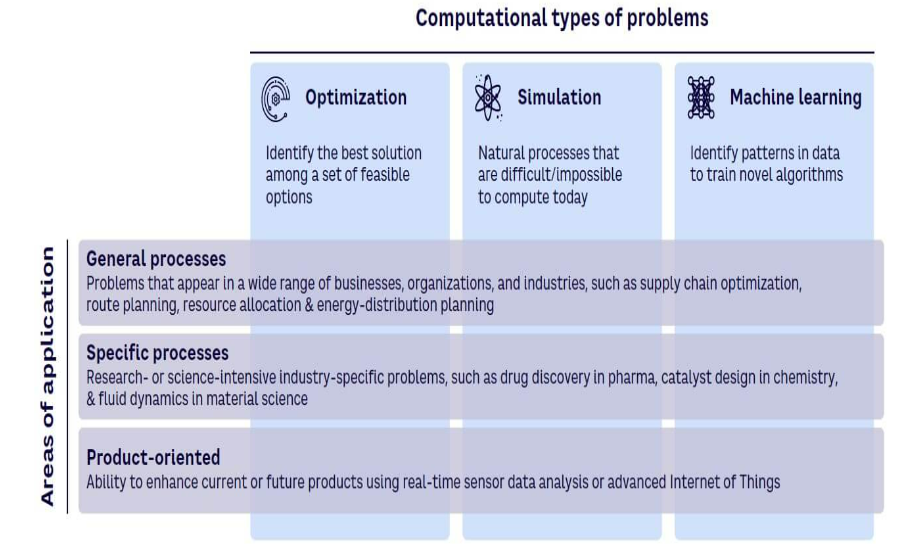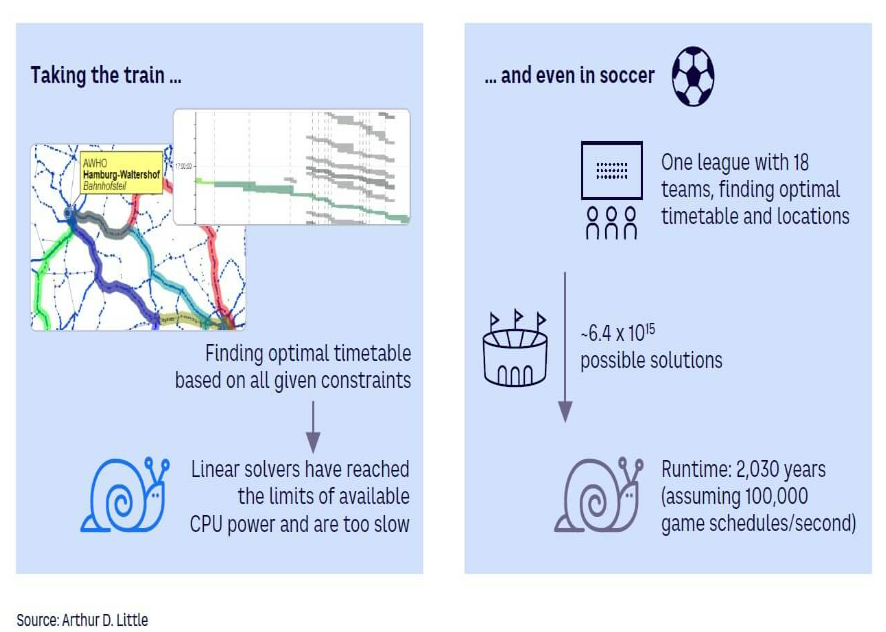Quantum systems will potentially be exponentially more powerful than other forms of computing. That’s a good thing, of course, but it’s also true that quantum is proportionately more complicated than other technologies, making reading and talking about it more difficult by orders of magnitude.
That’s why a new paper from the Arthur D. Little management consulting firm comes as a breath of fresh air. “Myths, Applications & Impacts of Quantum Computing” pulls off the neat trick of writing about QC in a comprehensible way. This is partly because the paper’s four authors* don’t engage in the futile exercise of trying to explain quantum phenomena, things like superposition and annealers. On the other hand, when they attempt to define a term they do it well – see below their succinct, four-word explanation of entanglement.
The paper takes on widely held quantum perceptions and misconceptions. Among the ADL analysts’ conclusions: quantum computing will happen sooner than we might think, and in some forms (emulators), quantum is happening now. Therefore, decision makers should begin laying the groundwork for quantum now.
“Companies have limited time to prepare for this revolution since the learning curve is steep and challenging,” assert the authors. “Quantum-native companies will enjoy major advantages over others, perhaps even changing entire industries.”

Credit: AD Little
Below are highlights from the paper. Let’s start with ADL’s QC definition:
Quantum physical phenomena allow for computing capabilities far beyond those of conventional computers. Most significantly, rather than being based on bits, which can only have a value of 0 or 1, quantum computers are based on qubits that can also exist in a state of “superposition,” and the value of their readout is probabilistic rather than deterministic. Together with the phenomenon of “entanglement,” which effectively links qubits, computing power grows exponentially with each additional qubit. QC therefore has the theoretical capability to solve so-called intractable problems involving exponentially increasing complexity….
Then they offer this cautionary message:
However, harnessing QC benefits requires organizations to see through the hype, overcome several common myths, and envision how QC can best fit into their business.
The first of the authors’ four quantum myths: Quantum won’t arrive for many years
“Recent acceleration in quantum research indicates major steps toward achieving stable and error-reduced quantum computers,… systems that can be operated at room temperature are already planned for around 2028. …there are already QC devices accessible to users, such as quantum annealers and quantum emulators (conventional supercomputers that emulate QC devices). Many organizations have already been using these to create small-scale experimental systems as proofs of concept….”
Another myth: QC is only for cutting-edge applications
“There is a persistent belief that the computing power promised by quantum computers will only be used in highly specialized applications, such as protein folding or cryptography. In fact, QC applications exist in almost every industry and area of business. For example, (assistance) with more mundane problems that are currently held back by computational complexity.”

A third myth: QC doesn’t exist yet, so I can’t start
“Valuable work can be done to create and test quantum-inspired algorithms (optimized for the quantum world), which can be run on these devices or on conventional CPU/GPU hardware,” say the authors. “Organizations can already do a lot to identify and explore relevant QC applications for their business, negotiate access to QC capacity, engage with the QC ecosystem, develop capabilities, educate business departments….”
The fourth myth: QC is expensive
“In the short term, early quantum computers will be cloud-based systems that customers can access on demand, so they do not have to invest in their own machines and infrastructure. Companies like IBM and D-Wave already offer licenses for access to quantum hardware. Quantum computers may also ultimately offer operating cost advantages over conventional computers, as they theoretically offer more computing power per unit of energy consumption.”
Much of the rest of the paper expands on the four myth themes, discusses anticipated, high-impact quantum applications, the performance improvements of quantum over classical supercomputing that can be expected and the first quantum workloads that may come online. It also offers a five-step strategy for preparing for QC.
* The Arthur D. Little authors: Sabina Jeschke, Lucas Könnecke, Dr. Fabian Doemer, Thomas Thiele.
- SEO Powered Content & PR Distribution. Get Amplified Today.
- PlatoData.Network Vertical Generative Ai. Empower Yourself. Access Here.
- PlatoAiStream. Web3 Intelligence. Knowledge Amplified. Access Here.
- PlatoESG. Carbon, CleanTech, Energy, Environment, Solar, Waste Management. Access Here.
- PlatoHealth. Biotech and Clinical Trials Intelligence. Access Here.
- Source: https://insidehpc.com/2023/10/ad-little-on-quantum-4-myths-and-5-ways-to-get-started/
- :has
- :is
- :not
- 1
- 2028
- 7
- a
- About
- about IT
- access
- accessible
- achieving
- Ad
- Additional
- advantages
- AIR
- algorithms
- allow
- almost
- already
- also
- among
- analysis
- and
- and infrastructure
- Anticipated
- applications
- ARE
- AREA
- around
- Arthur
- AS
- Assistance
- At
- attempt
- authors
- back
- based
- BE
- because
- been
- begin
- being
- belief
- below
- benefits
- BEST
- Beyond
- Breath
- business
- but
- by
- CAN
- capabilities
- capability
- Capacity
- challenging
- changing
- come
- comes
- Common
- Companies
- complexity
- complicated
- computational
- computers
- computing
- computing power
- consulting
- consumption
- conventional
- Cost
- Course
- create
- cryptography
- Currently
- curve
- Customers
- cutting-edge
- D-Wave
- decision
- define
- definition
- Demand
- develop
- Devices
- difficult
- do
- Doesn’t
- done
- Dont
- each
- Early
- ecosystem
- educate
- effectively
- energy
- Energy Consumption
- engage
- enjoy
- entanglement
- Entire
- envision
- Even
- Every
- example
- Exercise
- exist
- expands
- expected
- experimental
- Explain
- explanation
- explore
- exponentially
- fact
- far
- Firm
- First
- fit
- For
- forms
- four
- Fourth
- fresh
- from
- futile
- get
- good
- groundwork
- Grows
- hand
- happen
- Happening
- Hardware
- Harnessing
- Have
- Held
- high-performance
- highlights
- highly
- How
- HTTPS
- Hype
- i
- IBM
- identify
- Impacts
- improvements
- in
- increasing
- indicates
- industries
- industry
- Infrastructure
- into
- Invest
- involving
- IT
- learning
- licenses
- like
- Limited
- links
- little
- Lot
- Machines
- major
- Makers
- Making
- management
- many
- max-width
- May..
- message
- might
- misconceptions
- more
- most
- Myths
- New
- news
- now
- of
- off
- offer
- Offers
- on
- online
- only
- operated
- operating
- optimized
- or
- orders
- organizations
- Other
- Others
- over
- Overcome
- own
- Paper
- per
- performance
- perhaps
- phenomenon
- physical
- planned
- plato
- Plato Data Intelligence
- PlatoData
- potentially
- power
- powerful
- Prepare
- preparing
- problems
- promised
- proofs
- proportionately
- Protein
- Pulls
- Quantum
- quantum computers
- quantum computing
- quantum research
- Qubit
- qubits
- rather
- Reading
- relevant
- requires
- research
- REST
- Revolution
- Room
- Run
- say
- see
- several
- Short
- should
- significantly
- since
- So
- SOLVE
- some
- specialized
- stable
- start
- started
- State
- Steps
- Strategy
- such
- Supercomputing
- superposition
- Systems
- takes
- talking
- Technologies
- term
- test
- than
- that
- The
- their
- themes
- theoretical
- therefore
- These
- they
- thing
- things
- think
- Third
- this
- those
- Through
- time
- to
- together
- toward
- true
- trying
- Ultimately
- unit
- used
- users
- using
- value
- Way..
- ways
- we
- WELL
- when
- which
- why
- widely
- will
- with
- Work
- world
- writing
- yet
- zephyrnet













